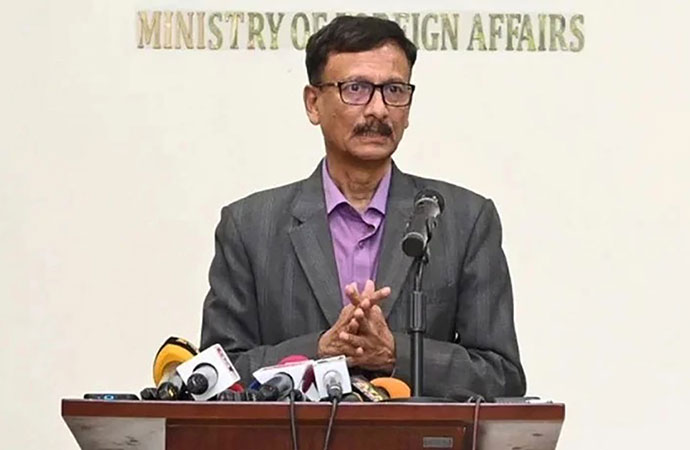Global

Watercock about to touch down. Photo: Enam Ul Haque
The male Watercock in full regalia sneaking through the grass did broadcast its booming calls in vain. But unfortunately, no female turned up to appreciate its gorgeous dark plumage, beautiful yellow bill and bright red helmet.
A strange, dark, chicken-like bird flying over the tree line veered towards us as the sun struggled to shine through a pile of clouds and morning mist. In an instant, we realised that the black chicken - with a ridiculous red spar on its head - could not be an ordinary fowl.
Immediately we lunged into the tall grass for cover. We did not want the bird to see us and fly away to a quieter place elsewhere. The mysterious bird was very likely to be a Watercock that did not care to be near the humans, even if they were bird-lovers.
We were in a village named Nayagaon, a little beyond Purbachal, and were photographing a field of beautiful white catkins we call 'kaashphul'. A small swamp covered with pink lily between the grass field and the village grove harboured a few furtive water-birds.
The mystery bird started to descend and spread its legs, intending to land in the swamp. We could clearly see its pitch-black face, beautiful yellow bill, blood-red forehead and the pink shield sticking above its head. It was undoubtedly a male Watercock in full breeding plumage.
The Watercock flew above the catkins and looked at us suspiciously. But eventually, it decided to land in the short grass at the edge of the swamp. Probably our green shirts and the willingness to stay frozen indefinitely did the trick. It was our first sight of a Watercock in 2021.
We had been looking for the elusive Watercock in and around Purbachal since June. June was the month when we first found the bird in Purbachal a year before. We saw a pair of those secretive birds nesting in the grass and raising two chicks on the bank of a beautiful lily pond.
Watercock breeds in monsoon. It lives in the 'haor' and other large wetlands in the dry season. From there, the Watercock moves to the smaller swamps and paddy fields to breed in the monsoon. Swamps produce the bird's favourite insects and seeds in the wet season.
In the monsoon, the male Watercock replaces its pale brown plumage with brand new black feathers. The bill turns bright yellow, and on its forehead grows a colourful shield. The males engage in long singing contests and bloody fights with each other for the attention of the females.
Monsoon makeover and aggression had endeared the Watercocks, incongruously, to our peace-loving ancestors somehow. The male Watercocks were their most sought-after pet a century ago. Every village had an ample populace of Watercock-fanciers.
The famous mystic poet Hasan Raja was a great Watercock-fancier of the past century. He kept about three hundred pet Watercocks, named every one of them attentively and wrote poems on the gifts and flaws. He penned an undying love for his pets in the following elegy:
"On my deathbed, pray my dear brethren
For me to get my Watercocks in heaven."
Unlike Hasan Raja, our love for Watercock would probably not transcend our lives on earth; but we are always thrilled to see it in our neighbourhood. Watercock used to be a common bird of our beels, baors, haors and the fields of 'aman'-paddy only a generation ago.
Now we can rarely see a Watercock anywhere in Bangladesh. Despite all the public love and affection of the past centuries, the population of this peerless bird of the marshland took a plunge as we went about reclaiming and polluting most of the swamps of our country.
Watercock population declined all over the Orient; the Orient is the only region the bird calls home. Fortunately, the decline elsewhere has not been as alarming as in Bangladesh, Nepal and Pakistan. The secretive bird does not do a good job in sharing swamps with the swelling human population.
We were fortunate to see a Watercock family breed at the edge of a lily-pond in Purbachal during the Covid-stricken monsoon of 2020. We saw the proud male poke its decorated head out of the lush green grass and the secretive female with two little chicks walk along the pond's edge.
The lily pond was soon decimated by a newly constructed restaurant and party centre all over the precious swamp. The families of Watercock, Bronze-winged Jacana and Yellow Bittern fled. The builders did not miss the birds: we were the few who grieved over the loss (TBS, 6 February 2021).
As the monsoon returned in 2021, we did not expect the Watercock to return to that ruined lily pond. We went to the pond anyway, in case the family of Watercock cared to revisit their breeding ground of yesteryears. No Watercock, jacana or bittern ever turned up.
We checked the nearby swamps and grassland for the birds displaced from the lily pond. Eventually, we were happy to find a few waterhens, jacanas and whistling ducks in and around the small swamp of Nayagaon. We, however, found no Watercock there the entire monsoon.
Then when the Watercock finally arrived, the monsoon was nearly over! It was rather late for a family of Watercock to go through the whole process of courtship, nest-building, incubating and chick-rearing in October-November. The swamp will be dry, and villagers will plough it by end-November.
We expected to witness some high-speed courtship if a female Watercock arrived in late September. We visited the little swamp of Nayagaon a few more times. The waterhens and the jacanas went on nipping the water-weeds while the whistling ducks snoozed. No female Watercock arrived.
The male Watercock in full regalia sneaking through the grass did broadcast its booming calls in vain. But unfortunately, no female turned up to appreciate its gorgeous dark plumage, beautiful yellow bill and bright red helmet.
Enam Ul Haque is the Chairman of WildTeam.
From The Business Standard

























Leave a Comment
Recent Posts
Remembering Kalidas Karmakar ( ...
The art world remembers Kalidas Karmakar, a visionary whose creativity ...
An Evening with Shishir Bhatta ...
Cosmos Art Echo, the artist talk initiative of Gallery Cosmos and Cosm ...
Myanmar denies genocide, calls Rohingya crackdown co ..
Yes, of course
Earth’s average temperature last year hovered among ..
Bangladesh and Singapore: A Tale of Two Nations